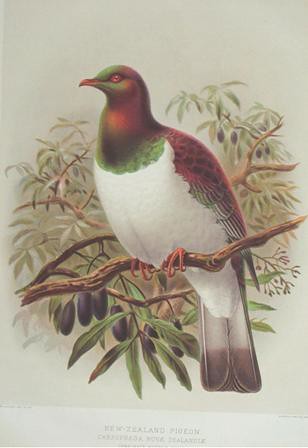Forbidden Pigeon
Monday, 17 March 2008 by Dr Maytel

The other day whilst sitting on my sister's deck surrounded by native bush in Auckland's Waitakere Ranges, a great big fat New Zealand wood pigeon or kereru landed in the nearby trees. We all stopped talking for a moment and silence fell, as the conversation sparked back up again, it turned out that we were all collectively thinking of the same thing in those small seconds....."I wonder it tastes like?"
Big fat native pigeons feed mainly on the plump fruit of native trees and were once in abundance in throughout the country but especially in the warmer climes of the North Island. They are big, and fat and often break the branches on which they try to sit. They have enormous breasts.
So why don't people eat the New Zealand wood pigeon.....Well first off, its illegal. Like most birds in New Zealand, their populations have declined massively with European settlement, not only through eating but through loss of habitat. Early explorers were said to have eaten a wide range of native New Zealand bird species -- kakapo, kokako, ducks, tui, weka, kaka, pukeko, robins, wrens, but most especially the kereru/kukupa. In addition the bird, like most NZ native birds are not well adapted to predation and also aren't good breeders
Wiki expands saying:
New Zealand Pigeons nest in trees, laying a single egg, in a flimsy nest constructed of a few twigs thrown together.
This propensity towards fleshy sweetness and shoddy nest building meant that in 1923 the kereru was given full protection under the Animals Protection and Game Act. The kereru has since been placed firmly off the pakeha (white person's) menu. Although all harvesting of kereru is illegal, some Maori tribes have continued to exercise their customary rights to hunting and eating kereru, often causing national uproar amongst the now non-kereru eating white middle classes of New Zealand. Many Maori however argue that the bird has special cultural significance, as detailed in the 1997 report on "Maori Customary Use of Native Birds, Plants and Other Traditional Materials" by the New Zealand Conservation Authority
Many Maori speakers at the hui and elsewhere also indicated some of the ways in which traditional uses are a means in to the spiritual dimensions of the Maori universe. These respondents recognised the particular importance of certain things to kaumatua and kuia facing sickness and death. Certain foods -- most controversially kereru -- are considered essential preparation and sustenance for the long journey into the next world. A request from a dying relative for this traditional strengthening food is a serious matter and many Maori feel that refusal would be impossible. Water from particular springs in the forest is also important to some people. The spiritual dimensions of certain foods and materials can also be of special value for pregnant women....Many non-Maori submissions argued that Maori craftspeople should replace traditional native materials with other things -- macrocarpa for carving, feathers from exotic gamebirds for weaving, and domestic fowls for traditional foods. Some people suggested using Tegel chicken flavoured with miro berries as a substitute for kereru....Another recent story tells of poached kereru being smuggled out of Southland hidden under a layer of muttonbirds in buckets; no serious investigation was undertaken or evidence provided before the story was circulated.
The illegality of kereru and its famed taste has led more daring types to flout the law and from time to time, whispers emerge about a friend of a friend who's eaten one of these legendary birds. They remain a select few who have sampled this delicacy. Hock's fishin' and huntin' uncle (Note to MFAT
The latest story I heard while sitting on my sister's balcony was a little more ethical. Her neighbour, although vegetarian, one day had a wood pigeon fly into her window and kill itself inside her house of concussion. At first, she thought nothing of it and threw it out the window, but on second thought she decided it would be a waste to leave it and found it, plucked it and cooked it. By all reports it was delicious.
One can only then hope and pray that a kereru will come and concuss itself on my door one day
